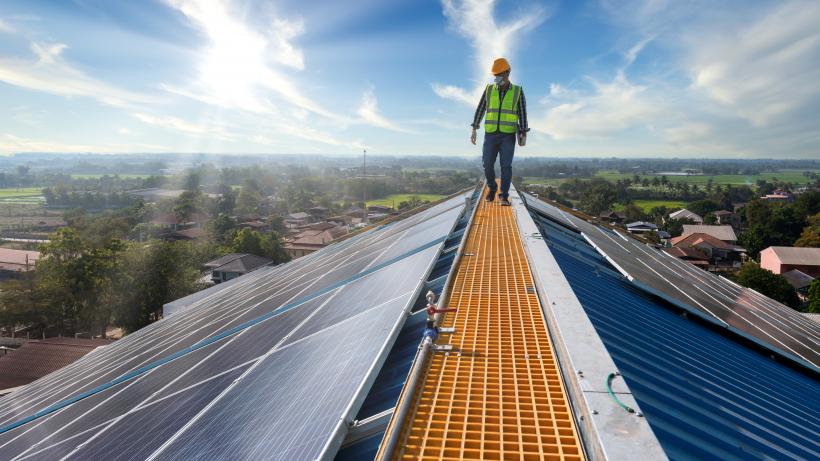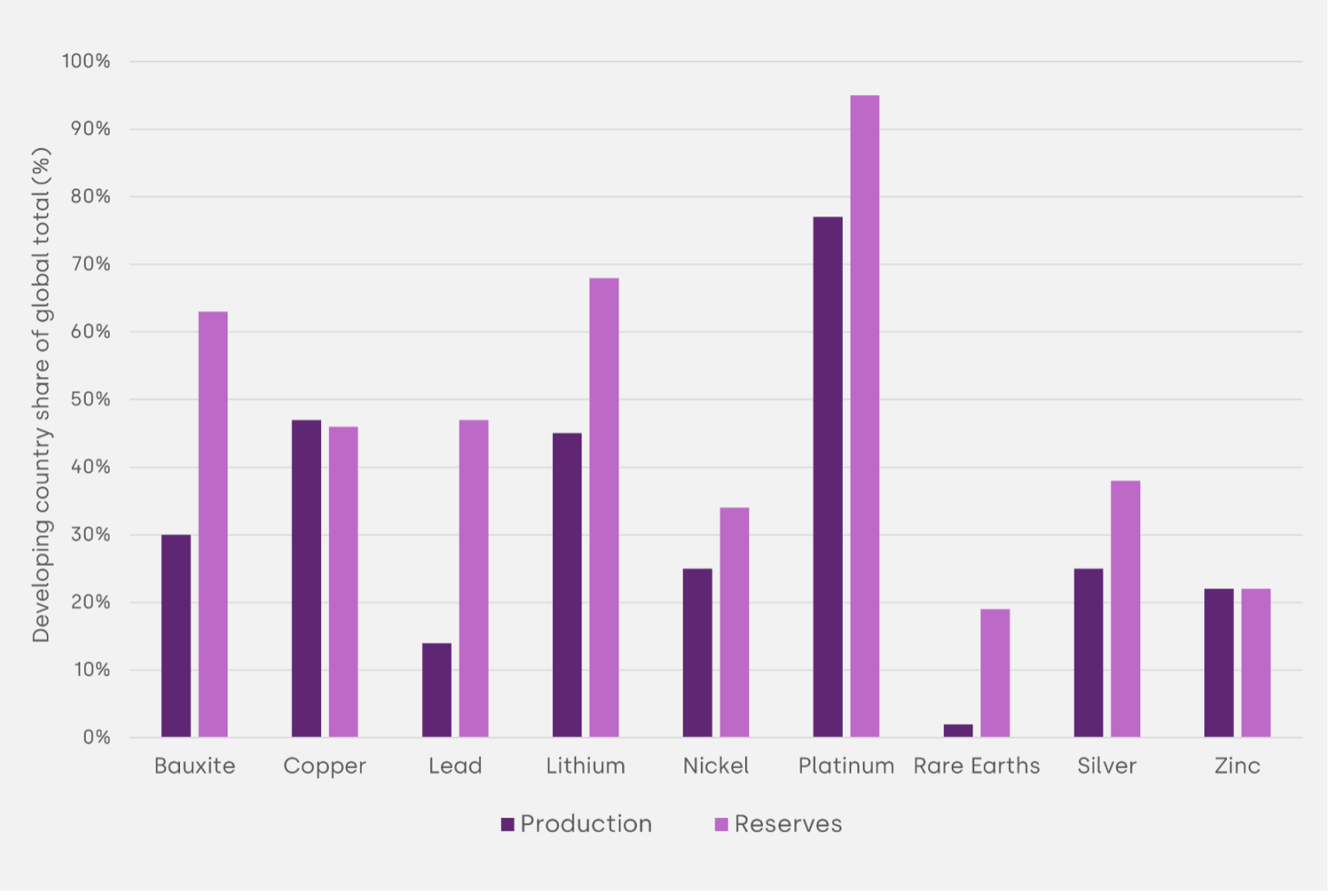
Sustainable urbanisation in developing countries: Cities as places to innovate, trade, and work
As the transition to a net zero global economy takes hold, there will be new opportunities for growth across a wide range of urban industries and services. City governments in sub-Saharan Africa and South Asia need to proactively plan how they will leverage this to deliver on local productivity and job creation objectives.
-
Delbridge et al Growth brief January 2023.pdf
PDF document • 1.45 MB
Introduction
The climate crisis urgently calls for a new environmentally sustainable and inclusive approach to growth (Stern and Valero 2021). Estimates suggest that inaction could cost the African economy between 10-15% of GDP by 2050, (Baarsch et al. 2020) and push an additional 35 million people in South Asia into poverty by 2030—doubling existing levels (Jafino et al. 2020). The only sustainable long-term option is shifting to a resource- and carbon-efficient development trajectory, and investing in strategies for adaptation (Hickel and Kallis 2020).
Cities in developing countries should identify comparative advantages, as well as strategically build new ones, to leverage climate action as an economic opportunity. These include contributing to the design or production of goods and services underpinning the net zero transition, and leveraging natural endowments in the renewable energy sources needed to fuel cleaner growth and attract green firms. Climate action at the city level can also create opportunities for low-skill employment, which will continue to constitute most of urban jobs, primarily in the informal sector. Developing countries need to embrace bold and transformative urban reforms, having a national strategic focus on cities and their green innovation, trade, and employment potential.
Key messages
- Urbanisation and the creation of modern employment opportunities must be undertaken with greater climate considerations.
- Cities can deliver on sustainable growth objectives by leveraging existing comparative advantages and building new ones.
- Developing countries have natural endowments that can contribute to the net zero transition, opening up opportunities for urban industries and services.
- Building the green cities of tomorrow can provide opportunities to absorb the large pool of low-skilled labour.
Acknowledgments: The authors would like to thank Sarah Colenbrander and Kagiso Tshukudu for their contributions to earlier versions of this work.
Key message 1 – Urbanisation and the creation of modern employment opportunities must be undertaken with greater climate considerations.
If harnessed correctly, urbanisation offers a huge opportunity for economic growth (Collier and Venables 2017). The density and connectivity of cities brings people together to share diverse ideas, connect firms and workers, and exchange goods and services—creating hubs of innovation and trade, and adding value beyond the primary sector. However, to date, urbanisation in the poorest countries—particularly in Africa—has contributed much less to development and poverty reduction than in other regions (Ravallion et al. 2007). A major reason is that African urbanisation has not gone hand-in-hand with large-scale, productive job creation (Kriticos and Henderson 2019). Instead, much of the labour transitioning from agriculture has moved into informal, non-tradable urban services (Gollin et al. 2016).
The climate challenge compounds this. Not only are developing countries urbanising with low incomes, but they are also facing additional environmental constraints that countries urbanising earlier did not have to contend with. This includes adapting to the increased risk of floods, droughts, and heat waves in developing country cities, as well as making room for climate-induced migration. Estimates suggest that Africa has been losing from 5-15% of its annual GDP per capita growth because of climate change and its related impacts (Urama 2022). Furthermore, the constraints also extend to the pressure imposed by global net zero commitments around the types of energy that can be used to fuel growth or meet international environmental and social responsibility standards (ADBG 2018).
Cities in developing countries need a pathway that minimises the negative and lasting impacts of climate change without compromising on their development and poverty alleviation priorities. Fortunately, despite these challenges, the net zero transition also creates new opportunities for productivity improvement and job creation in cities, as greener technologies, industries, and services emerge, and current ones are required to become more sustainable. Cities can tap into these economic opportunities, as well as reduce future risk by:
- doing ‘new sustainable things’
- doing ‘current things more sustainably’
- proactively adjusting to ‘shrinking opportunities’, such as phasing out coal and other carbon-intensive fossil fuels (Collier and Venables 2015)
There are four factors driving the transition: (1) consumers changing behaviour in response to new opportunities and information; (2) firms responding to demand changes and wanting to stay competitive; (3) markets adapting to new consumption and production choices, as well as pressures to internalise negative externalities, such as air and water pollution; and (4) governments driving change through regulation, financial support, and coordination efforts.
Importantly, the transition will be underpinned by innovation—both the development and deployment of low-carbon technologies across the economy. Indeed, in the long-term, growth is fundamentally driven by our ability to be more productive through innovative technologies and practices (Aghion et al. 1998). Cities, with their quantity and diversity of ideas, play a central role in spurring this innovation (Storper and Venables 2004). Cities also generate economies of scale, lowering the relative cost of diffusion and adoption of new technologies and practices (Wu et al. 2022). Governments should proactively plan for this transition, considering policies and approaches that could attract greener firms and create jobs.
Key message 2 – Cities can deliver on sustainable growth objectives by leveraging existing comparative advantages and building new ones.
Climate change is transforming the global economy—and will continue to do so. On the demand side, the global move to net zero emissions will see a changing economic environment, bringing new opportunities for growth and job creation. Approximately 80% of global carbon dioxide emissions, and approximately 90% of the global economy, are already accounted for in current net zero commitments (Net Zero Tracker n.d.). On the supply side, climate change alters the relative ability of cities, countries, and regions to carry out certain economic activities. In particular, evidence shows that large parts of Africa will become too hot for certain types of agriculture, and policymakers will need to adapt by shifting to different crops or other economic sectors (Conte et al. 2021).
High-emitting developed economies are better positioned to push the technological frontier forward and invest in the necessary science that will be required to deliver the net zero transition. Meanwhile, green global value chains (GGVCs) will emerge, whereby various stages of activity contributing to the production of goods and services that facilitate this transition will be shared across the world.
Developing country cities need to get ahead of this by identifying, leveraging, and building green comparative advantages, positioning themselves to reap the benefits of this economic change and guard against the risks. A green comparative advantage is anything the city can do more competitively than others, by leveraging or building on its local economic capabilities (such as their skills and natural endowments), and which are aligned with sustainable growth objectives. Opportunities include designing or producing goods and services underpinning the green transition, as well as processing minerals needed for low-carbon technologies or reducing the carbon intensity of existing goods. Without successful identification of existing and the development of new comparative advantages, regions will struggle economically and socially, and are likely to experience higher migration to more hospitable climates (Conte 2022).
Many new green opportunities are likely to be in cities, as many urban jobs, by virtue of their higher wages, indoor nature, and connection to global markets, are more resilient to the impacts of climate change. Furthermore, while global, GGVCs touch down in cities, and offer urban firms and workers an opportunity to contribute higher value-added goods in secondary and tertiary sectors (Crescenzi and Harman 2023). This could be in the processing of resources into an intermediate good, or facilitating the development, design, or distribution of a good. In low-income cities that are still developing, lower complexity products and services are a useful place to start. Figure 1 below shows the ranking of countries in Africa and Asia by green production potential, based on existing goods exports.
Figure 1: Africa and South Asia’s green production potential
Notes: This index measures, in relative terms, how much potential a country has to diversify into green, more complex products in the future (ranking ranges from 1—best positioned—to 122). This potential is based on the connectedness and complexity of products it is not yet competitive in. In other words, it shows which countries in Africa and South Asia are relatively most ready to leverage more complex, green GVCs in global trade. In Africa, it shows that South Africa, Senegal, Tanzania, and Uganda all have relatively high potential, with the latter rising significantly in recent years. In South Asia, it shows that India has one of the leading global green production potentials, with Sri Lanka and Pakistan also relatively far ahead. Grey indicates data unavailable. More information for application can be found at https://green-transition-navigator.org/. Source: Data from (Mealy and Teytelboym 2022).
Cities can also build their own comparative advantage through investments in the broader technologies that will attract greener firms. Examples include policies that support clean energy supply and lower-emitting infrastructure development. Simply designing cities with higher density, more greenery, and lower environmental pollution—covered in more detail in the companion piece Delbridge et al. (2022)—can play an important role in attracting these green firms. The same is true for regulations that protect the city’s natural capital. For example, accrediting processed forestry products with sustainable certification, or producing a good with higher environmental standards, such as increasing recycled content in cement or reducing carbon emissions in activities through renewable energy. In the tertiary sector, it could mean demonstrating climate commitments, such as the hospitality industry reducing water consumption through low-flow showerheads or reclaiming used water for ground-keeping (Grove et al. 1996).
Governments should proactively plan for this transition. GVC mapping is one tool to aid in the identification of comparative advantages—showing whether cities should compete on existing strengths or invest in developing new ones (For detail see Sutton (2014) and Frederick (2019)). To develop upgraded industries, cities need to engage with larger firms to understand what skills and infrastructure they might require for such upgrading to take place locally (Crescenzi and Harman 2022). With new industries, it is important to also consider what other countries are doing to leverage their comparative advantage. If cities attempt to specialise in the same or similar niches, the overall supply might outstrip demand. Alternatively, where demand is sufficiently high, cities might benefit from actively coordinating supply across a certain region. Continental bodies, such as the African Union with the African Continent Free Trade Area, or the South Asian Association for Regional Cooperation with the South Asian Free Trade Area, are useful bodies to coordinate economic action under collaboration rather than competition.
Key message 3 – Developing countries have natural endowments that can contribute to the net zero transition, opening up opportunities for urban industries and services.
Natural endowments have historically played a dominant role in the economies of many of the poorest countries in the world. In Africa, on average, fossil fuel exports constituted 37% of total exports in 2020 (authors’ own calculations based on data from The Growth Lab at Harvard University (2022) in line with Oramah (2022)). However, the IEA predict that, by 2050, the global energy supply will drop from 60% coal, natural gas, and oil under business-as-usual, to 20% under net zero (IEA 2022). Countries will need to find ways of redeploying and upgrading their existing capabilities towards new opportunities, which can contribute to sustainable urbanisation objectives. These include exploiting the potential for renewable energy generation, such as solar, wind, and hydropower, as well as the extraction and processing of mineral resources that go into building low-carbon technologies.
While Africa and South Asia enjoy high renewable energy potential, most of this remains untapped. When it comes to solar, Africa is home to 40% of the global potential, but just over 1% of installed capacity (Mo Ibrahim Foundation 2022). Furthermore, while hydropower is Africa’s primary form of renewable energy, African countries are exploiting only 11% of the potential available (Addleshaw Goddard and Association 2021). Wind energy, geothermal energy, and green hydrogen are only beginning to be harnessed.
Figure 2 shows the share of electricity coming from renewable energy sources across Africa and South Asia. Currently, 22 African countries have renewables as their primary source of electricity generation (Mo Ibrahim Foundation 2022) while in South Asia, it is Bhutan and Nepal who primarily rely on renewable energy, largely coming from hydropower (Triyana and Li 2022). For some of these countries, the high proportion of renewables does not translate to a high absolute amount of electricity generation, as installed capacity—and therefore access—in much of Africa and South Asia is relatively low. Instead, they are still reliant on other off-grid non-renewable energy sources for cooking, heating, and transport. Despite this, the development pathways created through initial investments in renewable energy rather than coal will ensure cities develop more sustainably, and with stronger advantages in the production of greener goods and services.
Figure 2: Share of electricity from renewables in Africa and South Asia
Notes: Globally, around one-quarter of electricity comes from renewables. This is varied regionally, with averages of 2015 – 2020: Europe – 34.6%; Asia Pacific – 21.9%; Africa – 19.5%; Middle East – 2.6%; North America – 22.3%, South and Central America – 64%; Oceania – 27.5%. Grey indicates data unavailable. Source: Authors’ calculations based on data compiled by Our World in Data, with Africa and South Asia primarily drawn from BP Statistical Review of World Energy.
The high costs of transporting cleaner energy sources bring further comparative advantage to developing countries. This is because cleaner energy sources have a lower energy concentration than fossil fuels (Li et al. 2010). They also lose between 50-80% of initial energy during the conversion process necessary for it to travel long distances (Giddey et al. 2017). These distributional impacts will be felt both between countries—where those rich in renewables and other cleaner energy sources will develop stronger comparative advantages in heavy industry; and within countries—where locations near the source of these energy will be preferred sites of production (Hausmann 2022).
Cities in developing countries can also go beyond simply employing cleaner energy to decarbonise existing production and attract new green firms by manufacturing intermediary goods which are part of renewable technologies themselves. Such value add could start in lower-complexity goods, such as lead-acid electric accumulators—which provides for energy storage in off-grid PV system—or liquid dielectric transformers, used for initial assembly, repair, and maintenance of wind energy systems. While Africa’s share of inventive activity in the field of mitigation is relatively low compared to the rest of the world, evidence shows it is rapidly increasing in energy storage, hydrogen, fuel cell technologies, and renewable energy (UNEP 2013). For example, South Africa is innovating with green hydrogen production to decarbonise the smelting process of nickel (Fitch Solutions 2021).
In order to deliver on this potential, the global shift to net zero will almost quadruple demand for the materials and ‘critical metals’ needed as inputs to renewable energy and low-carbon technologies by 2040 (IEA 2020). As with renewable energy, developing countries also hold most of the world’s reserves in these minerals, but are not yet taking full advantage of it. On average, developing countries are holding 2.5 times more in current reserves of key ‘low-carbon’ transition metals than they are producing, while for rare earths in particular, this value is even greater—with developing countries holding 10 times more in reserves than they produce (see Figure 3).
Figure 3: Developing country production and reserves of key ‘low carbon’ transition materials

Notes: For low carbon use: Bauxite – Solar PV cells; Copper – Solar PV; Lead – Hybrid vehicles; Lithium – Electric vehicles; Nickel – Renewable batteries; Platinum – Hydrogen vehicles; Rare Earths (a group of 17 critical metals) – Multiple use, including wind turbines; Silver – Electric vehicles and solar panels; Zinc – Energy storage and renewable energy system longevity. Source: Data from (Arrobas et al. 2017).
New demands bring the opportunity to exploit different minerals in urban industries and services. For example, Neodymium, one of the 17 rare earth metals, is required for magnets used in generators of wind turbines and electric vehicles. While 85% of this is currently mined in China (Nansai et al. 2014), mines in Burundi and Malawi hold promising sources of the metal (Statista 2021). Similarly, copper is used on average five times—but up to 40 times—more intensively in renewable energy systems than in fossil–fuel-equivalent energy production (Strong 2017) & (Hertwich et al. 2015). Many countries already have the technologies to extract it and could reap the benefits of growing demand. Higher value-added tasks include preparing the alloy and processing the product, or service activities, such as marketing and design. Rare earth mines near Migowi city, Malawi, are already attempting to drive local employment through new local content agreements, improved infrastructure, and investing in processing plants (Mkango Resources Ltd 2022).
Importantly, the mining industry itself can be very energy and water intensive, which means it will need to be done more sustainably (Hausmann 2022). Furthermore, over a third of nickel reserves are in areas of high biodiversity or water stress, with by-products from processing being very harmful for environment pollution and health impacts (Smith 2018). Growing service industries related to environmental accreditation of mines and managing the negative impacts on the surrounding environment are therefore another opportunity to upgrade into higher-value activities.
Across both renewable energy and minerals, it is not only the endowment of the resource that matters, but also other factors that affect the overall comparative advantage in producing and processing it. This includes the cost of capital, which greatly influences the viability of investing in renewables in a particular location, as well as capabilities in managing the long-lead times for planning, permitting, and construction. Strong institutional capacity is also needed to effectively manage ‘the resource curse’—in other words, the failure to show enhanced economic performance from natural resources due to mismanagement of revenues and commodity cycles (see Humphreys et al. (2007) for escaping the curse and Collier and Laroche (2015) for harnessing natural resources).
Key message 4 – Building the green cities of tomorrow can provide opportunities to absorb the large pool of low-skilled labour.
The green transition in many developing country cities, particularly in urban Africa, is taking place in a largely low-skilled and informal economic environment (Acey and Culhane 2013). With inadequate formal jobs and limited social protection, work in the informal economy has become the most common option for developing country citizens (Campbell and Ahmed 2012)—constituting 81% of all urban employment in sub-Saharan Africa, and 71% in South Asia (ILO 2018). The informal economy is typically characterised by low-productivity, non-tradable activities; by contrast, many green economy initiatives happen in capital-intensive, technologically sophisticated industries that do not generate many jobs in poor settings (Lankao 2007).
However, with active public policy, low-skilled workers can play an important role in climate action at the city level. While the long-term focus should be on reskilling and upskilling workers into greener, higher-productivity occupations across the economy (Oliveira-Cunha 2022), at the outset, there is merit in greening existing economic activities that have high labour-absorption potential. One route is through building the sustainable city of 2050. In addition to the immediate employment benefits, as well as the adaptation and mitigation benefits outlined in the companion piece—(Delbridge et al. 2022), a sustainable city will also play a large role in attracting greener firms in the future, contributing to national sustainable growth objectives.
One example is greening the building and construction industry, which is often the mainstay of employment in expanding cities (Collier and Venables 2017). As the physical city grows, there is a need for builders, electricians, roofers, plumbers, and many others labour-intensive occupations. By training the workforce with more sustainable building and construction techniques, this large sector can contribute to a number of municipal objectives. For example, it can improve access to good quality and climate-adapted housing for the urban poor (ILO 2018), while also contributing to emission reductions. Buildings are currently responsible for 39% of global energy related carbon emissions—with 28% from energy needed to heat, cool, and power them, and the remaining 11% from materials and construction (Adams et al. 2019). It also provides the (green) urban jobs that are necessary to accommodate urban population growth. For example, in Zambia, a programme created a framework to boost demand for environmentally friendly building materials, products and methods. It also provided training in green building and construction for small and medium enterprises, and created an additional 2500 jobs while improving the quality of 2000 existing ones (ILO 2015).
Waste management is another example of labour-intensive sector that could contribute to generating urban jobs, while building a more climate-resilient, less polluting city. Indeed, recycling of solid waste is one of the cheapest and fastest ways to reduce GHG emissions in a labour-intensive way (WIEGO 2012). Reducing one ton of carbon dioxide emissions through recycling costs 30% less than doing so through energy efficiency, and 90% less than through wind power (Skumatz 2008). Currently, 1% of the urban workforce in developing countries is employed in recycling—including collecting, recovering, sorting, grading, cleaning, compacting, and processing waste into new products—but millions of additional jobs could be created with an active focus on this sector (ILO 2018).
Green job creation can also ultimately expand through trade in these sectors. For instance, in building and construction, cities can explore the potential for trading things like bamboo flooring panels, cross-laminate timber, clay bricks, and mycelium. These goods are all far more environmentally sustainable than cement, and draw on the abundant natural resources in many developing countries (See WTO (2014) and APEC (n.d.) for further examples). Special waste streams can also be commoditised. For example, it was estimated in 2019 that there was a US$ 57 billion industry of processing and recycling electronic devices and re-exporting their metals (Forti et al. 2020). In Ghana specifically, the e-waste economy was estimated to be the equivalent of 0.55% of GDP (Prakash et al. 2010), with the average e-waste collector earning more than four times that of the average civil servant (Amankwaa et al. 2016). Domestically extracting precious minerals from e-waste provides an opportunity for the development of a recycling industry which can generate urban jobs, as well as contribute to preserving resources and controlling pollution (Kumwenda 2022).
Other examples of local job creation in building a sustainable city include investing in public works programmes for the provision of ecosystem services, and greening local energy sources which are often used for cooking and water heating, outside of the main electricity grid.
Policy recommendations
As developing countries rapidly urbanise, and the transition to a net zero economy takes hold, developing countries need to proactively plan how they will leverage this to their benefit. New markets and associated value chains will be created to serve the growing demand for low-carbon goods and services. Others, such as fossil fuel production and associated products, will shrink. This will have many implications for modern growth and employment opportunities. Cities need to leverage and build green comparative advantages. Making use of the abundant natural resources needed to build greener, higher value-added industries, as well as leveraging the supply of low-skilled workers to build the sustainable city of tomorrow, are two ways that countries can meet sustainable growth objectives, while also contributing to adaptation and mitigation goals.
- Place urbanisation at the centre of national efforts to promote sustainable growth.
Climate change is not simply an issue of adaptation and mitigation, but also one of economic opportunities in which cities have a large role to play. Investing in adapting to climate change and mitigating increased emissions are important. But, in addition to this, developing countries should look to harness the new economic opportunities that climate change and the global transition to net zero will bring. As centres of innovation, trade, and work, cities are well placed to champion this change. Well-managed, sustainable urbanisation should therefore be a national priority.
- Map current GVC positions to understand existing specialisms and potential future green products and services.
To understand which GVCs to develop—whether building new ones or reshaping existing ones—the process of GVC mapping is crucial. This is because the approach each city should take in order to deliver upon this economic development will be different depending on its unique set of natural, human, and physical capital. Mapping current and future comparative advantages shows whether cities should compete on existing strengths or invest in developing new ones.
- Engage with new or adapting industries and invest in the skills and infrastructure needed to increase the local value-add in production.
Currently, much of the higher value-added activities are done in developed cities, but as new green demands emerge there will be new opportunities for developing cities to get ahead. Cities who can provide new, greener firms with certainty that they have the skills, infrastructure, and connectivity to create the value locally—or are willing to put this in place—stand to gain from this opportunity.
- Adapt to declining demand for fossil fuels, and instead leverage the abundant natural endowments needed for low-carbon technologies.
The global transition to net zero emissions will cause a relative decline in fossil fuel use. It will also increase demand for renewable energy sources and the minerals necessary to service the green transition. Countries need to adjust proactively to these changing opportunities. Policymakers in developing countries can benefit by pivoting investment and policy towards these alternative mineral reserves and renewable energy endowments. Urban leaders can then grow new industries through value-added manufacturing and service tasks, supporting both innovation and dispersion of new technologies.
- Absorb low-skilled workers in green urban jobs through building the sustainable, productive, and liveable city of tomorrow.
The low-skilled workforce will continue to drive a large proportion of the economic activity that takes place in developing country cities. There is merit in working to facilitate more and better jobs for this large pool of low-skilled, mostly informal workers. Small policy changes and investments may help them do ‘current things more sustainably’—for example, in building and construction, and waste management provision. This focus on non-tradable services can contribute to building the sustainable, productive and liveable city of 2050 and beyond, which in the long-term can attract greener firms and provide further job opportunities.
References
Acey, C. S., and Culhane, T. H. (2013). Green jobs, livelihoods and the post-carbon economy in African cities. Local Environment, 18(9), 1046-1065.
Adams, M., Burrows, V., and Richardson, S. (2019). Bringing embodied carbon upfront: Coordinated action for the building and construction sector to tackle embodied carbon. World Green Building Council. London, WorldGBC.
ADBG. (2018). Annual Report 2018. Retrieved from online at <https://www.afdb.org/en/documents/annual-report-2018>:
Addleshaw Goddard, and Association, I. H. (2021). An Investor’s Guide to Hydropower in Africa.
Aghion, P., Howitt, P., Howitt, P. W., Brant-Collett, M., and García-Peñalosa, C. (1998). Endogenous growth theory. MIT press.
Amankwaa, E., Tsikudo, A., and Bowman, J. (2016). Recyclers at risk? Analysis of e-waste livelihoods and blood lead levels at Ghana’s recycling hub, Agbogbloshie. International Growth Centre Policy Brief.
APEC. (n.d.). ANNEX C – APEC List of Environmental Goods.
Arrobas, D., Hund, K., Mccormick, M., Ningthoujam, J., and Drexhage, J. R. (2017). The Growing Role of Minerals and Metals for a Low Carbon Future.
Baarsch, F., Granadillos, J. R., Hare, W., Knaus, M., Krapp, M., Schaeffer, M., and Lotze-Campen, H. (2020). The impact of climate change on incomes and convergence in Africa. World Development, 126, 104699.
Campbell, D., and Ahmed, I. (2012). The labour market in developing countries. Perspectives on Labour Economics for Development. (ILO, 2013).
Collier, P., and Laroche, C. (2015). Harnessing natural resources for inclusive growth. International Growth Centre Policy Brief.
Collier, P., and Venables, A. J. (2015). Closing Coal: economic and moral incentives. Oxford Review of Economic Policy, 30(3), 492-512.
Collier, P., and Venables, A. J. (2017). Urbanization in developing economies: the assessment. Oxford Review of Economic Policy, 33(3), 355-372.
Conte, B. (2022). Climate change and migration: the case of Africa. CESifo Working Paper 9948.
Conte, B., Desmet, K., Nagy, D. K., and Rossi-Hansberg, E. (2021). Local sectoral specialization in a warming world. Journal of Economic Geography, 21(4), 493-530.
Crescenzi, R., and Harman, O. (2022). Climbing up global value chains: Leveraging FDI for economic development. Hinrich Foundation Report.
Crescenzi, R., and Harman, O. (2023). Harnessing Global Value Chains for regional development: How to upgrade through regional policy, FDI, and trade. London: Routledge.
Delbridge, V., Harman, O., Oliveira-Cunha, J., and Venables, A. (2022). Sustainable urbanisation in developing countries: Cities as places to live. International Growth Centre Growth Brief Series 026.
Fitch Solutions. (2021). Africa Nickel Developments: Opportunities And Risks For Participation In The Battery Revolution.
Forti, V., Baldé, C., Kuehr, R., and Bel, G. (2020). The Global E-waste Monitor 2020: Quantities, flows and the circular economy potential. Retrieved from Bonn/Geneva/Rotterdam: Co-hosted SCYCLE Programme, International Telecommunication Union, International Solid Waste Association.
Frederick, S. (2019). Global value chain mapping. In Handbook on global value chains: Edward Elgar Publishing.
Giddey, S., Badwal, S. P. S., Munnings, C., and Dolan, M. (2017). Ammonia as a Renewable Energy Transportation Media. ACS Sustainable Chemistry and Engineering, 5(11), 10231-10239.
Gollin, D., Jedwab, R., and Vollrath, D. (2016). Urbanization with and without industrialization. Journal of Economic Growth, 21(1), 35-70.
Grove, S. J., Fisk, R. P., Pickett, G. M., & Kangun, N. (1996). Going green in the service sector. European Journal of Marketing, 30(5), 56-66.
Hausmann, R. (2022). Green Growth Opportunities. IMF Finance and Development.
Hertwich, E. G., Gibon, T., Bouman, E. A., Arvesen, A., Suh, S., Heath, G. A., . . . Shi, L. (2015). Integrated life-cycle assessment of electricity-supply scenarios confirms global environmental benefit of low-carbon technologies. Proceedings of the National Academy of Sciences, 112(20), 6277-6282.
Hickel, J., and Kallis, G. (2020). Is green growth possible? New Political Economy, 25(4), 469-486.
Humphreys, M., Sachs, J. D., Stiglitz, J. E., Humphreys, M., and Soros, G. (2007). Escaping the resource curse: Columbia university press.
IEA. (2020). Energy Technology Perspectives 2020. IEA.
IEA. (2022). World Energy Outlook 2022 Free Dataset.
ILO. (2015). Green jobs programme. Annual Impact Report Zambia 2015.
ILO. (2018a). Women and men in the informal economy: a statistical picture (Third Edition). Geneva, International Labour Organisation.
ILO. (2018b). World Employment Social Outlook: Greening with Jobs.
Jafino, B. A., Walsh, B., Rozenberg, J., and Hallegatte, S. (2020). Revised estimates of the impact of climate change on extreme poverty by 2030. Policy Research Working Paper, 9417.
Kriticos, S., and Henderson, J. V. (2019). The prospects for manufacturing-led growth in Africa’s cities. International Growth Centre Growth Brief Series 020.
Kumwenda, M. (2022). Climate priorities: Challenges and opportunities for e-waste in Rwanda. International Growth Centre Blog.
Lankao, P. R. (2007). Are we missing the point? Particularities of urbanization, sustainability and carbon emissions in Latin American cities. Environment and Urbanization, 19(1), 159-175.
Li, Y., Chen, H., Zhang, X., Tan, C., and Ding, Y. (2010). Renewable energy carriers: Hydrogen or liquid air/nitrogen? Applied Thermal Engineering, 30(14), 1985-1990.
Mealy, P., and Teytelboym, A. (2022). Economic complexity and the green economy. Research Policy, 51(8), 103948.
Mkango Resources Ltd. (2022). Mkango Produces Neodymium and Praseodymium Enriched Rare Earth Carbonate From Final Piloting as Feasibility Study for Songwe Hill in Malawi Nears Completion. GlobalNewswire.
Mo Ibrahim Foundation. (2022). The Road to COP27: Making Africa’s Case in the Global Climate Debate. Forum Report
Nansai, K., Nakajima, K., Kagawa, S., Kondo, Y., Suh, S., Shigetomi, Y., and Oshita, Y. (2014). Global Flows of Critical Metals Necessary for Low-Carbon Technologies: The Case of Neodymium, Cobalt, and Platinum. Environmental Science and Technology, 48(3), 1391-1400.
Net Zero Tracker. (n.d.). Net Zero Tracker,. Retrieved from https://zerotracker.net
Oliveira-Cunha, J. (2022). Front-lining green jobs in the sustainable urbanisation agenda. International Growth Centre Blog.
Oramah, B. (2022). Transiting to green growth in fossil export-dependent economies: A pathway for Africa. Global Policy, 13(4), 542-546.
Prakash, S., Manhart, A., Amoyaw-Osei, Y., and Agyekum, O. O. (2010). Socio-economic assessment and feasibility study on sustainable e-waste management in Ghana.
Ravallion, M., Chen, S., and Sangraula, P. (2007). New Evidence on the Urbanization of Global Poverty. Population and Development Review, 33(4), 667-701.
Skumatz, L. (2008). Recycling and climate change: Finding the “Biggest Bang” Community Strategies for Reducing GHG. Resource Recycling, 27, 14-17.
Smith, C. (2018). African energy from waste projects: A plethora of opportunities. Energy Source.
Statista. (2021). Reserves of rare earths worldwide as of 2021, by country. Retrieved from https://www.statista.com/statistics/277268/rare-earth-reserves-by-country/
Stern, N., and Valero, A. (2021). Innovation, growth and the transition to net-zero emissions. Research Policy, 50(9), 104293.
Storper, M., and Venables, A. J. (2004). Buzz: face-to-face contact and the urban economy. Journal of Economic Geography, 4(4), 351-370.
Strong, Z. (2017). The Rise Of Solar: A Unique Opportunity For Copper. Solar Industry Magazine. Retrieved from https://issues.solarindustrymag.com/article/rise-solar-unique-opportunity-copper#bio
Sutton, J. (2014). An enterprise map of Mozambique (Vol. 5): International Growth Centre.
The Growth Lab at Harvard University. (2022). Export basket in 2020 [for each African country].
Triyana, M., and Li, Y. (2022). Green Energy Can Accelerate Sustainable Growth Across South Asia. Retrieved from https://blogs.worldbank.org/endpovertyinsouthasia/green-energy-can-accelerate-sustainable-growth-across-south-asia
UNEP. (2013). Patents and clean energy technologies in Africa.
Urama, K. (2022). African countries ownership in determining climate agenda.Paper presented at the Egypt International Cooperation Forum Cairo, Egypt.
WIEGO. (2012). Urban Informal Workers and the Green Economy. Fact Sheet.
WTO. (2014). Environmental Goods Agreement.
Wu, J., Segerson, K., and Wang, C. (2022). Is environmental regulation the answer to pollution problems in urbanizing economies? Journal of Environmental Economics and Management, 102754.
Citation
Delbridge, V., Harman, O., Oliveira-Cunha, J., & Venables, A., (2022). Sustainable urbanisation in developing countries: Cities as places to innovate, trade, and work. International Growth Centre Growth Brief Series 027.





